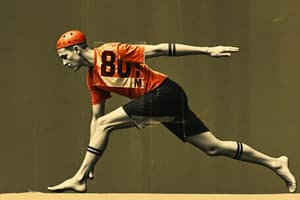Podcast
Questions and Answers
What is the relationship between joint stability and mobility?
What is the relationship between joint stability and mobility?
- Increased mobility leads to decreased stability. (correct)
- Both stability and mobility are independent factors.
- Increased stability leads to increased mobility.
- No relationship exists between them.
Which of the following factors can influence joint range of motion (ROM)?
Which of the following factors can influence joint range of motion (ROM)?
- Muscle tone (correct)
- Time of day
- Dietary habits
- Emotional state
What is the main purpose of using a goniometer?
What is the main purpose of using a goniometer?
- To assess joint pain.
- To evaluate the range of motion at a joint. (correct)
- To determine posture alignment.
- To measure muscle strength.
Which of the following is NOT a reason for limitations of motion (LOM)?
Which of the following is NOT a reason for limitations of motion (LOM)?
What does AROM stand for in joint measurement?
What does AROM stand for in joint measurement?
Which type of assessment would be described as a formal assessment?
Which type of assessment would be described as a formal assessment?
What is generally indicated by WNL and WFL during joint assessments?
What is generally indicated by WNL and WFL during joint assessments?
Which of the following would NOT typically affect the evaluation of ROM?
Which of the following would NOT typically affect the evaluation of ROM?
What does AROM stand for in joint movement assessments?
What does AROM stand for in joint movement assessments?
In the context of joint mobility, what does the term 'subluxation' indicate?
In the context of joint mobility, what does the term 'subluxation' indicate?
What is the purpose of the 'end-feel' during joint assessment?
What is the purpose of the 'end-feel' during joint assessment?
How should the non-affected side be positioned during AROM assessment?
How should the non-affected side be positioned during AROM assessment?
When assessing the gap in the acromion process, how is it measured?
When assessing the gap in the acromion process, how is it measured?
What type of ROM involves the therapist providing support during the client's active movement?
What type of ROM involves the therapist providing support during the client's active movement?
What is essential to know for proper joint mobility measurement?
What is essential to know for proper joint mobility measurement?
What common condition in stroke patients may lead to subluxation?
What common condition in stroke patients may lead to subluxation?
What does WNL signify in joint mobility assessment?
What does WNL signify in joint mobility assessment?
Which condition is considered a contraindication for joint mobility assessment?
Which condition is considered a contraindication for joint mobility assessment?
In Goniometry assessment, what should be done first?
In Goniometry assessment, what should be done first?
What is indicated by WFL in a joint mobility context?
What is indicated by WFL in a joint mobility context?
Which of the following steps is NOT part of the active range of motion assessment?
Which of the following steps is NOT part of the active range of motion assessment?
Which condition should you record during active range of motion assessment?
Which condition should you record during active range of motion assessment?
During the passive range of motion assessment, which step follows noting the starting range?
During the passive range of motion assessment, which step follows noting the starting range?
What does AROM stand for in joint mobility assessment?
What does AROM stand for in joint mobility assessment?
What is the purpose of observing completeness, symmetry, and timing during joint mobility assessment?
What is the purpose of observing completeness, symmetry, and timing during joint mobility assessment?
Which of the following movements corresponds with assessing shoulder extension?
Which of the following movements corresponds with assessing shoulder extension?
In the context of goniometry, what does 'stationary arm' refer to?
In the context of goniometry, what does 'stationary arm' refer to?
What does the acronym 'AROM' stand for in joint mobility assessment?
What does the acronym 'AROM' stand for in joint mobility assessment?
Which movement is assessed during shoulder horizontal abduction?
Which movement is assessed during shoulder horizontal abduction?
When assessing elbow flexion and extension, what position should the arms start in?
When assessing elbow flexion and extension, what position should the arms start in?
What is a common characteristic of an assessment tool like goniometry in evaluating joint mobility?
What is a common characteristic of an assessment tool like goniometry in evaluating joint mobility?
What should be done if upper extremity range of motion appears limited?
What should be done if upper extremity range of motion appears limited?
What is the primary purpose of conducting Active Range of Motion (AROM) assessment?
What is the primary purpose of conducting Active Range of Motion (AROM) assessment?
During a Passive Range of Motion (PROM) assessment, what should be documented?
During a Passive Range of Motion (PROM) assessment, what should be documented?
What is the correct format for documenting the range of motion?
What is the correct format for documenting the range of motion?
When positioning the client for an assessment, how should the joints be aligned?
When positioning the client for an assessment, how should the joints be aligned?
What should be done to prevent substitution during a joint assessment?
What should be done to prevent substitution during a joint assessment?
How is hyperextension recorded in a goniometry assessment?
How is hyperextension recorded in a goniometry assessment?
Which of the following requires documentation during the goniometry assessment?
Which of the following requires documentation during the goniometry assessment?
In which situation is it appropriate to indicate the term 'fused joint'?
In which situation is it appropriate to indicate the term 'fused joint'?
Flashcards are hidden until you start studying
Study Notes
Joint Stability
- Assessment includes evaluating the available range of motion (ROM) in joints.
- Joint stability is inversely related to joint mobility, meaning increased stability results in decreased mobility, and vice versa.
Joint Mobility
- Range of Motion (ROM) refers to the degree of movement possible at a joint.
- Limitations of Motion (LOM) can arise from injury, disease, trauma, or disuse.
- Personal factors like age, obesity, developmental conditions, and injuries affect ROM.
Evaluation of ROM
- Goniometry is the standard measurement technique for assessing ROM objectively.
- Both Active Range of Motion (AROM) and Passive Range of Motion (PROM) need to be assessed:
- AROM: Client initiates movement, demonstrating control.
- PROM: Therapist assists in moving the joint, assessing joint stability.
Joint-End Feel
- Describes the sensation experienced when a joint reaches its maximum PROM, indicating resistance to further movement.
- Types of end-feel include soft, firm, and hard, each representing different joint conditions.
Principles of Joint Measurement
- Knowledge of average normal ROM and joint anatomy is crucial for accurate assessment.
- Stability and proper positioning of the patient and therapist ensure effective measurement.
- AROM measurements are obtained while avoiding compensatory movements from adjacent joints.
Goniometry Assessment Procedure
- Requires assessment of both sides of the body to establish a baseline for comparison.
- Document movements in degrees and specify any signs of pain, swelling, or spasticity.
- ROM results are categorized as:
- WNL (Within Normal Limits): ROM within established norms.
- WFL (Within Functional Limits): ROM may not be normal but allows for performance of daily activities.
Functional Assessments
- Informal assessments may be conducted before proceeding to formal measurements.
- Observations can identify the need for more detailed analysis if limitations are present.
Documentation
- Goniometry results should be recorded with clear notation of joint positions and angles.
- Detailed documentation aids in understanding and tracking progress over time.
Studying That Suits You
Use AI to generate personalized quizzes and flashcards to suit your learning preferences.



